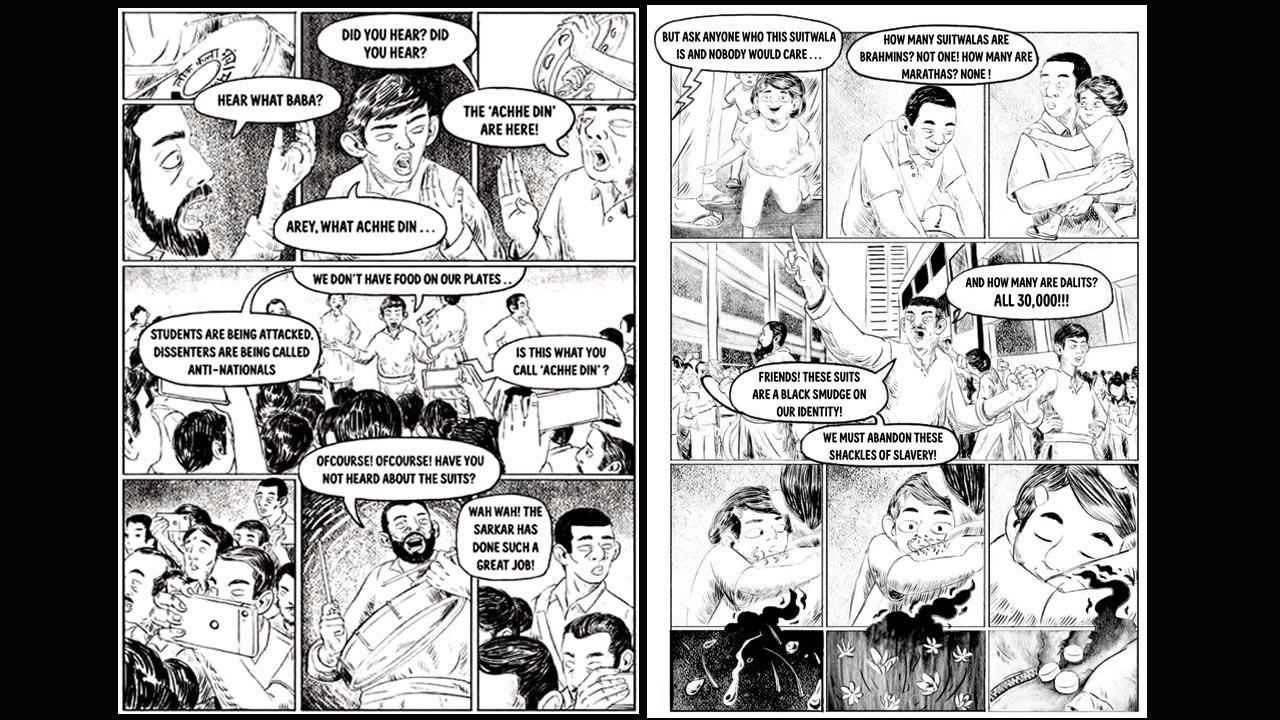A graphic novel takes us into Mumbai of the near future, where safai karamcharis have topnotch safety equipment and equal rights, but still fail to live a life of dignity

The book revolves around Vikas, a conservancy worker from Mumbai of the future, who finds himself stuck in the vicious circle of casteism despite having a secured government job and safety equipment, including a full-body suit
Does anyone know how people die in sewers? That’s the question author-illustrator Samarth poses to his readers, right at the beginning of his just-released debut graphic novel, Suit (Yoda Press, Rs 295). The answer comes to the reader immediately in a distressing graphic of a mouse reacting to Hydrogen Sulfide (H2S) gas—typically formed in wastewater collection systems—as it slowly enters the rodent’s body. The human body responds in a similar manner, slowly slipping into a coma. The book then takes readers into the city of Mumbai of the future, where manual scavenging has been eliminated and conservancy workers are relatively more secure with safety equipment, including a full-body suit, leading to them being called “suitwalas”. They also have government jobs, consistent salary, and ID cards—all assuring a hope of a better future. Despite this, Vikas, a safai karamchari, and the protagonist of the novel, finds himself stuck in the vicious circle of casteism. “I think it was very important for me to delve into the humane side of my protagonist. He has seen his father, also a manual scavenger, dying in a sewer. He has also seen work conditions of his community improve for the better. He shares a relationship with his daughter that is very different from the one he shared with his father, has access to opportunities and yet nothing is perfect. This transition was something very central to the story,” says Samarth, 25, an alumnus of IDC School of Design, over a telephonic interview.
ADVERTISEMENT
The idea for the book, that’s available in bookstores, came to Samarth, who prefers to be identified by his first name, in 2017, when he went to Israel for an exchange programme and volunteered to teach filmmaking in collaboration with an NGO in Palestine for a month. “It was a system of violence, oppression and cruelty, institutionalised by the Israeli government towards the people of Palestine. After I returned to India, I realised I was getting more affected by injustice around me. Not that I wasn’t aware of the violence and injustice earlier, but it had started bothering me more,” says Samarth, who grew up in Mumbai.
A series of events, including a chance meeting with Sudhanva Deshpande of Jana Natya Manch, a New Delhi-based amateur theatre company specialising in street theatre, and witnessing Sudharak Olwe’s photo exhibition, In Search Of Dignity and Justice, which documented the lives of manual scavengers, moved him deeply. “Olwe’s pictures stayed with me; it is one thing to be aware of the reality, but it is another to witness it,” recalls Samarth.
Soon after, he approached Milind Ranade, general secretary of the Kachra Vahatuk Shramik Sangh (KVSS), who put him in touch with members of the community. He spent close to two weeks in Mankhurd, observing manual scavengers, as they went about their daily chores. “A lot of lived realities came to the forefront during this period,” adds Samarth, who identifies himself as a caste less upper class person and is well aware of his privilege. “My grandfather was a believer of the Ambedkarite movement and thus, caste was never discussed or highlighted at our home. It was during college when I came in contact with the Ambedkar Periyar Study Circle, a student organisation, and I was introduced to the reality of the weight I hold and the amount of space that I take up in this world,” shares Samarth.
Although it began as a college project, which Samarth couldn’t finish at the time due to time constraints, he went back to it soon after he graduated from college in 2020. This time the characters had created a life of their own in his head and were ready to decide the course of their journey. “The understanding of the story that I had dabbled around for most part of last year of my college life started taking shape two years ago. They were no longer puppets in my hand catering to my narrative, but had feelings and emotions, which in some manner surpassed what I could imagine myself. They took a life of their own and guided me in the process of representing them,” he explains.
Apart from Vikas, the novel features multiple characters, who have different narrative arcs. It is what perhaps clicked with many acclaimed writers, including Meena Kandasamy and Sudhanva Deshpande, who have showered Samarth with appreciation. “It gives me a lot of hope. What I feel most grateful for is the sense of acknowledgement and inclusion, from people who have written on this or similar subjects,” concludes Samarth, adding that he has another novel in the pipeline that revolves around the Malvan coast of Maharashtra.
 Subscribe today by clicking the link and stay updated with the latest news!" Click here!
Subscribe today by clicking the link and stay updated with the latest news!" Click here!







